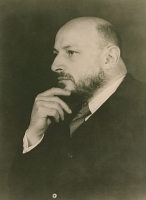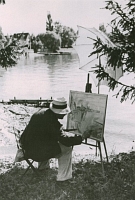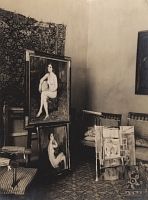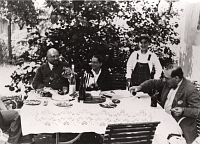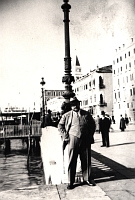Berlin/ Langenargen 1916-1935
1916
In late January, Purrmann moves to Berlin where he resides at Franzensbaderstr. 3 in the neighborhood of Berlin-Grunewald until 1923 (see Dresslers Kunsthandbuch 1921, p. 462). His studio is in Berlin-Schmargendorf, Marienbaderstr. 1. He writes to his brother of his extraordinary success, relating that even museums were buying paintings from him. Alongside his painter friends Rudolf Levy, Rudolf Grossmann, Konrad von Kardorff, and Max Slevogt, he is a regular at the Romanisches Café; another café guest was Karl Scheffler, the art historian and editor of the important journal “Kunst und Künstler”. Purrmann is in lively correspondence with Scheffler from the early nineteen-twenties on (twenty-four of Purrmann’s letters are in the archives of the Academy of Arts in Berlin). He comes to know the writer Johannes Guthmann, who acquires many of his paintings. Purrmann visits with Heinz Braune again in Glonn (in the southeast of Munich) and paints a second portrait of Braune’s wife Mary. After lengthy medical treatment in Heidelberg, Purrmann’s mother Elisabeth dies in Speyer in April. On September 16, 1916, his daughter Regina (1916–1997) is born. During this period, Purrmann also spends time in Nenndorf, near Hanover.
1917
Max Raphael publishes an “art letter” to Purrmann, discussing two studio interiors of the artist that he had seen in an exhibition in Zurich.
1918
Purrmann’s first major solo exhibition takes place before the end of World War I, in the spaces of Paul Cassirer’s Berlin gallery. An illustrated catalogue is published for the exhibition. For the occasion of the show, Curt Glaser writes the first major essay on Purrmann, which appears in “Kunst und Künstler”. Along with Glaser, Purrmann visits Erna Schilling, the companion of Ernst Ludwig Kirchner, and views the latter’s studio in Berlin.
1919
At the suggestion of Liebermann and Slevogt, Purrmann is named member to the Prussian Academy of Arts in Berlin, as well as a member of the acquisitions committee of the National Gallery. The event is announced with a photograph in the “Weltspiegel” of April 6, 1919. The Berlin Academy offers Purrmann a professorship, but he declines; he receives the title of professor in this period from a Bavarian academic institution (a fact related by Dr. Adolf Leisen, Speyer).
On October 21, Purrmann signs a contract to acquire a fisherman’s house in Langenargen, on the shores of Lake Constance, in which he would live and work regularly from then until 1935. He had previously also considered a summer residence in the Palatinate and in the vicinity of Würzburg. The house is sold after Mathilde’s death in 1943.
The ongoing contact between Purrmann and the art critic Wilhelm Uhde is documented by the many postcards from Uhde to Purrmann. In a piece for “Kunst und Künstler”, Purrmann congratulates Hans Thoma on the occasion of his eightieth birthday, Purrmann’s first documented publication. Together with Curt Glaser, Purrmann offers suggestions for improving Berlin exhibitions.
On October 21, Purrmann signs a contract to acquire a fisherman’s house in Langenargen, on the shores of Lake Constance, in which he would live and work regularly from then until 1935. He had previously also considered a summer residence in the Palatinate and in the vicinity of Würzburg. The house is sold after Mathilde’s death in 1943.
The ongoing contact between Purrmann and the art critic Wilhelm Uhde is documented by the many postcards from Uhde to Purrmann. In a piece for “Kunst und Künstler”, Purrmann congratulates Hans Thoma on the occasion of his eightieth birthday, Purrmann’s first documented publication. Together with Curt Glaser, Purrmann offers suggestions for improving Berlin exhibitions.
1920
The studio in Langenargen is completed. Purrmann embarks on a journey to Rome, joined by Heinz Braune and Paul Cassirer.
Mathilde goes to Paris “on business” (Mathilde’s passport, Hans Purrmann Archiv) from August through September of 1920. During those months, the Purrmann belongings left behind in Paris in the apartment and studio, including furniture and works of art, are auctioned at the Hotel Drôuot.
Purrmann’s first notes on Matisse appear in the journal “Genius”. The year also witnesses Purrmann’s travels to Silesia, including the cities of Breslau and Schreiberhau (Purrmann’s captions on the back of photographs of subjects for watercolors). It may have been on this trip that Purrmann meets the collector Max Silbermann, who is from Breslau (see Heilmann, pp. 85–87).
Mathilde goes to Paris “on business” (Mathilde’s passport, Hans Purrmann Archiv) from August through September of 1920. During those months, the Purrmann belongings left behind in Paris in the apartment and studio, including furniture and works of art, are auctioned at the Hotel Drôuot.
Purrmann’s first notes on Matisse appear in the journal “Genius”. The year also witnesses Purrmann’s travels to Silesia, including the cities of Breslau and Schreiberhau (Purrmann’s captions on the back of photographs of subjects for watercolors). It may have been on this trip that Purrmann meets the collector Max Silbermann, who is from Breslau (see Heilmann, pp. 85–87).
1921
Purrmann is extensively discussed in Karl Scheffler’s book „Talente“ (Berlin, 1921), a discussion upon which Scheffler later expands in an item in the journal „Kunst und Künstler“ entitled “Hans Purrmann und der moderne Kolorismus.”
1922
In the summer months, Purrmann travels with his family to Sorrento on the Gulf of Naples. Rudolf Grossmann, who accompanies them, make a series of drawings that are later included as illustrations to Annette Kolb’s 1925 story “Veder Napoli e partire”.
The artist is mentioned in Glaser’s definitive book „Die Graphik der Neuzeit“ (Berlin, 1922). Purrmann continues his output as an author, publishing three essays, one entitled “Aus der Werkstatt Henri Matisses,” (From Henri Matisse’s workshop) another “Formlose Notizen über Graphik,” (Formless notes about graphics) and a third observing the death of Reinhard Lepsius. He also furnishes an introduction for the catalogue of his friend Rudolf Levy, and, in the pages of “Kunstblatt”, responds to the question Ein neuer Naturalismus? (A new naturalism?)
The artist is mentioned in Glaser’s definitive book „Die Graphik der Neuzeit“ (Berlin, 1922). Purrmann continues his output as an author, publishing three essays, one entitled “Aus der Werkstatt Henri Matisses,” (From Henri Matisse’s workshop) another “Formlose Notizen über Graphik,” (Formless notes about graphics) and a third observing the death of Reinhard Lepsius. He also furnishes an introduction for the catalogue of his friend Rudolf Levy, and, in the pages of “Kunstblatt”, responds to the question Ein neuer Naturalismus? (A new naturalism?)
1923
Purrmann moves his main residence to Rome, where he remains until 1927. His children go to school there. In the spring of 1923, the year of hyperinflation, he is in Rome and Sorrento. He makes paintings of the Mediterranean coast, using the so-called Villa Gorki as a subject. He makes his first paintings of the Roman Forum. Joined by Hermann Ebers, he begins copying paintings in the Galleria Borghese, including a work by Titian.
1924
In June and July, he journeys to Sorrento, taking detours to Naples. Scheffler’s 1930 book “Künstleranekdoten” relates that Purrmann went to Ischia for the first time in this year, along with his fellow painters Kardorff and Hans Spiegel. Purrmann takes time on Ischia to work on his printed graphic art (see Heilmann, pp. 89–90), and is believed to have met with Matisse in September.
1925
Purrmann has a solo show in Basel at the Galerie Pro Arte. The opening speech is given by Purrmann’s friend Friedrich Rintelen (1881–1926), professor of art history in Basel, of whom the painter had made a portrait during his years in Munich.
1926
Purrmann spends the spring of 1926 in Munich and Venice. In July and September, he returns to Langenargen, where he paints the interior of the Church of St. Martin. In October, he goes to Paris, where he visits with the collectors Sarah and Leopold Stein as well as Matisse’s wife.
1927
Purrmann is back in Rome in the spring of 1927. On June 16, Purrmann is in Langenargen, and writes his fellow painter Wohlgemuth: “... yesterday I returned from Rome. For the past five years, I have spent my winters in Italy and only the summers here on Lake Constance. In Berlin I still have my studio and apartment (but rented), and have not been there at all the entire time! Yet, this winter I will be in Berlin again; Italy has become too expensive for me, and, after all, people have to see me back in Berlin again.” A major solo show is mounted in Kaiserslautern (fig. 10). Purrmann writes his first autobiographical notes, entitled “Aus meinem Leben,” for the catalogue.
1928
Purrmann is given his own show in Nuremberg, comprised of twenty-one of his works, within the context of the exhibition “Pfälzer Kunst von Churfürst Carl Theodor bis zur Gegenwart”. By then he had moved to Lützowufer 13 in Berlin, an apartment above Alfred Flechtheim’s gallery.
Purrmann publishes “Van Gogh und wir. Die gefälschte Kunst. Expertisen–Restaurierungen–Fälschungen,” as well as “Über deutsche Malerei und ihre internationale Bewertung.”
1929
A newspaper article on Curt Glaser contains a photograph of Glaser’s circle in which Purrmann appears next to Karl Scheffler. One of Purrmann’s still lifes hangs next to paintings by Edvard Munch.
Purrmann submits twenty-eight watercolors as his competition entry for the design of the Chapel of St. Roch in Hohenecken, near Kaiserslautern, the main memorial in the Palatinate to the fallen soldiers of World War I. His entry is not selected. His stay in Hendaye, near Bayonne is cut short by an acute case of typhus, one from which he and his wife would continue to suffer for years.
In a contribution in “Kunst und Künstler”, Purrmann conveys his best wishes to Max Slevogt, who had turned sixty. He also contributes a discussion of Flechtheim’s Berlin exhibition of works by André Derain and expresses views critical of a lecture by Scheffler in a contribution in the journal “Kunstauktion”.
In a contribution in “Kunst und Künstler”, Purrmann conveys his best wishes to Max Slevogt, who had turned sixty. He also contributes a discussion of Flechtheim’s Berlin exhibition of works by André Derain and expresses views critical of a lecture by Scheffler in a contribution in the journal “Kunstauktion”.
1930
In April, the press honors Purrmann on the occassion of his fiftieth birthday, and he receives the Ehrenpreis des Reichsministeriums des Inneren (Special Prize of the Reichs Interior Ministry). For the occasion, Curt Glaser writes on April 15, “Had Purrmann’s art been better understood, German painting would have been spared a number of false starts. Let us desire that this fifty-year-old artist, now in the full blossom of his artistic powers, at last, enjoys the broad influence and recognition that his works deserve ...”.
Purrmann enjoys a tremendously productive summer stay at Sanary-sur-Mer, together with his colleague Heinrich Brüne, who lives in Wessling, near Munich. He also makes a number of new acquaintances, including Werner Gilles.
Purrmann writes a foreword for the Matisse exhibition at Flechtheim’s gallery in Berlin. Observations of Purrmann’s are published under the title “Malereien der Kinder.”
Purrmann enjoys a tremendously productive summer stay at Sanary-sur-Mer, together with his colleague Heinrich Brüne, who lives in Wessling, near Munich. He also makes a number of new acquaintances, including Werner Gilles.
Purrmann writes a foreword for the Matisse exhibition at Flechtheim’s gallery in Berlin. Observations of Purrmann’s are published under the title “Malereien der Kinder.”
1931
Purrmann travels to Paris, meets with Matisse, and goes to exhibitions, including one of Picasso’s. He spends time in Venice, where he paints watercolors exclusively.
In May, he learns that he has been commissioned to design the front of the meeting hall in the Rathaus of Speyer. After an extended exploratory process that can be traced through a series of watercolors, he settles on executing an Allegory of Art and Science in the form of a triptych.
Writing in “Kunst und Künstler” on the occasion of the 1931 Academy exhibition, Karl Scheffler makes express reference to Purrmann’s work in Sanary-sur-Mer.
In May, he learns that he has been commissioned to design the front of the meeting hall in the Rathaus of Speyer. After an extended exploratory process that can be traced through a series of watercolors, he settles on executing an Allegory of Art and Science in the form of a triptych.
Writing in “Kunst und Künstler” on the occasion of the 1931 Academy exhibition, Karl Scheffler makes express reference to Purrmann’s work in Sanary-sur-Mer.
1932
Purrmann carries out an initial full-size cartoon of the triptych (held by the Landesmuseum Mainz). He tests the on-site effect by hanging the cartoons at the Rathaus and taking photographs from a variety of angles. The canvases, which Purrmann completes around mid-year, are first introduced to a wider public in July at the Academy of Arts in Berlin. Shortly before their permanent installation in the Rathaus in December, a defamatory debate took place in Speyer as to whether the paintings should be put up at all.
In „Kunst und Künstler“, Purrmann discusses Slevogt’s frescoes in Ludwigshafen. He also congratulates the publisher Bruno Cassirer with an essay in the Festschrift that appears to celebrate Cassirer’s sixtieth birthday.
In „Kunst und Künstler“, Purrmann discusses Slevogt’s frescoes in Ludwigshafen. He also congratulates the publisher Bruno Cassirer with an essay in the Festschrift that appears to celebrate Cassirer’s sixtieth birthday.
1933
In May, Purrmann spends three weeks taking the waters in Karlsbad. On May 18, 1933, he writes Brüne from there: “I have now spent a long time in Berlin and have moved to Genthiner Strasse 13 Berlin W 35, it saves me a great deal on rent and makes it easier for me to travel again! I have been working a great deal, exhibiting a great deal. Again and again, the paintings come back unsold. For two years now, I have sold nothing but a few watercolors. One can very nearly despair when one’s profession does nothing but bring in expenses and no income at all.”
Purrmann is among the artists against whom a National Socialist-indoctrinated campaign was directed. It weighs on him heavily:
“I had the greatest difficulties in Speyer; they wanted to [illegible] my paintings and now they are nailed shut with swastika flags hung over them; at least they are safe for the time being, not more than two or three people intervened on my behalf and the Kampfbund and the Notgemeinschaft Pfälzer Künstler [the “Battle League” and the “Emergency Action Organization of Artists of the Palatinate,” two National Socialist-linked organizations–trans.] have sent around circulars saying that the past era must be swept away and that reactionary liberal paintings must be eliminated and this letter, which got forty-nine to fifty positive responses, was signed by that whore swine [Hurenschwein], the painter Fay, who also painted a painting in the Rathaus, and what is sadder yet is that the painter Haueisen is with them too. A large Palatinate exhibition is going on in Berlin now and I was not invited at all!” (Letter to Brüne, December 22, 1933) An exhibition of the Swiss painter Alfred Heinrich Pellegrini is organized at the Kunsthalle in Basel, and Purrmann is able to participate. He is not mentioned on the catalogue cover.
Purrmann’s last publication for some years is dedicated to the art of the South Seas. He gives shelter to the artist Thomas Theodor Heine, who was sought by the Nazis, and assists him in getting out of Germany into Czechoslovakia. Captions on the back of photographs of subjects for watercolors as well as the acqusition date of the Graphic Collection of the Staatsgalerie Stuttgart (W 1933/04) demonstrate that Purrmann did not travel to Trento for the first time in 1939, but had already been in 1933.
Purrmann is among the artists against whom a National Socialist-indoctrinated campaign was directed. It weighs on him heavily:
“I had the greatest difficulties in Speyer; they wanted to [illegible] my paintings and now they are nailed shut with swastika flags hung over them; at least they are safe for the time being, not more than two or three people intervened on my behalf and the Kampfbund and the Notgemeinschaft Pfälzer Künstler [the “Battle League” and the “Emergency Action Organization of Artists of the Palatinate,” two National Socialist-linked organizations–trans.] have sent around circulars saying that the past era must be swept away and that reactionary liberal paintings must be eliminated and this letter, which got forty-nine to fifty positive responses, was signed by that whore swine [Hurenschwein], the painter Fay, who also painted a painting in the Rathaus, and what is sadder yet is that the painter Haueisen is with them too. A large Palatinate exhibition is going on in Berlin now and I was not invited at all!” (Letter to Brüne, December 22, 1933) An exhibition of the Swiss painter Alfred Heinrich Pellegrini is organized at the Kunsthalle in Basel, and Purrmann is able to participate. He is not mentioned on the catalogue cover.
Purrmann’s last publication for some years is dedicated to the art of the South Seas. He gives shelter to the artist Thomas Theodor Heine, who was sought by the Nazis, and assists him in getting out of Germany into Czechoslovakia. Captions on the back of photographs of subjects for watercolors as well as the acqusition date of the Graphic Collection of the Staatsgalerie Stuttgart (W 1933/04) demonstrate that Purrmann did not travel to Trento for the first time in 1939, but had already been in 1933.
1934
Purrmann spends the beginning of the year in Florence. In February he travels to Breslau and Schreiberhau (both in Silesia), where Johannes Guthmann lives. In September, Purrmann, along with his painter colleagues Hugo Troendle and Rudolf Hoerschelmann from Munich, travel together to the Corot exhibition in Zurich. In November, Purrmann takes his last trip to Paris before the war, where he meets Matisse again.
In 1933 and 1934, Purrmann gives a number of paintings to Dr. Lucas Lichtenhan, director of the Kunsthalle in Basel, for sale on commission, thus hoping for income from the sale of his works.
In 1933 and 1934, Purrmann gives a number of paintings to Dr. Lucas Lichtenhan, director of the Kunsthalle in Basel, for sale on commission, thus hoping for income from the sale of his works.
1935
The burial of Max Liebermann is on February 11. Purrmann is among the mourners present. A painting by Purrmann is removed from the exhibition Berliner Kunst in München in the Neue Pinakothek in Munich.






